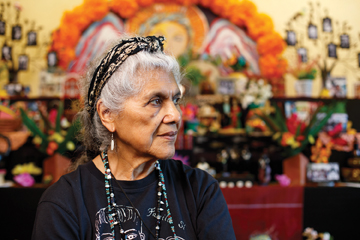Altarista Ofelia Esparza Headed to Smithsonian
Although she will blush and shudder with nervous embarrassment to hear it said, or read aloud from these pages, Doña Ofelia Esparza is clearly on her way to becoming synonymous with the ofrenda. Literally an “offering,” the ofrenda, or “altar” is a spiritually-based expression of reverence or love traditionally assembled to honor the lives of departed loved ones. Today, however, it is just as likely to represent an idea or a political message.
In the course of a quiet and unassuming second-act career as a fine artist over the last 30-years, Ofelia has earned a pristine reputation as one of the nation’s preeminent altar-makers. Widely acknowledged as a leading exponent and master practitioner of a cultural tradition she was first made aware of in her household as a young girl, the East L.A. native and former school teacher embraces her eighth decade on earth in stride.
Balancing her role as the wise matriarch and perennial source of maternal comfort for the nine adult children she brought into the world and the grandchildren that have followed with status as an unofficial ambassador for Día de Los Muertos, she is asked with increasing frequency to help explain its significance, origin and meaning for those only now discovering its reach.
With gentle yet unwavering purpose, she approaches the autumn of her life and a relentless calendar of professional engagements, commissions for the creation of site-specific altars and invitations to participate in exhibitions across the country with an unmatched generosity. A recent request to create a Día de los Muertos altar highlighting indigenous aspects of the tradition at the Smithsonian’s American Indian Museum in Washington D.C. is merely the latest example of the increasingly national and international stature Doña Ofelia has achieved.
“We’re really excited about going,” says graphic designer and printmaker Rosanna Esparza Ahrens, Ofelia’s eldest daughter and primary collaborator on larger-scale altar installations. “It’s us along with Liliflor [Ramírez], who’s going to be doing an interactive mural. They’re bringing us out a few days before. But we’re preparing a lot of the material for the altar here. So if you want to drop by anytime this week and learn how to make paper flowers, feel free,” Esparza Ahrens adds with a laugh.
During the early months of 2018, the mother-daughter team was commissioned to create a permanent altar at the Los Angeles Museum of Natural History as part of an enhanced reboot of the exhibition called “Becoming Los Angeles.” A striking and visually arresting addition to a permanent exhibition originally installed in 2013, their Altar to el Pueblo de Nuestra Señora la Reina de los Ángeles (the Town of Our Lady the Queen of Angels) references historical moments and geographical places, and a cross-section of Angeleno voices within the city, along with flowers and animals that inhabit greater L.A. Many of these are symbolically represented through miniatures and tiny, hand-painted architectural replicas.
“We did wind up doing quite a bit of research and I learned some things about L.A. I didn’t know, so it was very interesting,” says Ofelia. The altar celebrates the diversity and cultural richness of L.A., featuring objects that celebrate local neighborhoods, photos of iconic city figures and musicians, a woven textile representing the Los Angeles River, and flowers that appear to have burst out exuberantly everywhere, a reminder of mother earth’s awesome power to reassert its natural beauty.
The invitation to join the celebration at the Smithsonian American Indian Museum this year will mark Doña Ofelia’s return to the nation’s capital as a traditional artist working in a traditional art form. In September, 2018, she was acknowledged at a ceremony in the Library of Congress’ Thomas Jefferson Building as the recipient of a National Heritage Fellowship, a lifetime recognition presented to master folk and traditional artists by the National Endowment for the Arts, and the highest honor bestowed in the U.S. for achievement in the folk and traditional arts.
In a special Día de los Muertos episode of Craft in America, PBS’ popular series on folk and traditional arts—aired nationally on Sept. 29th, 2017, a year before being honored and acknowledged as a Heritage Fellow, Ofelia looks squarely at the camera and offers a bit of the wisdom gleaned on visits to cemeteries with her own mom: “My mother always said we experience three deaths,” she says. “The first is the day we give our last breath. The second is the day we’re buried. And the most dreaded death is to be forgotten. This is the essence of the celebration.”
For Maestra Ofelia Esparza, constructing the altar and assembling the objects, mementos, photos, trinkets, possessions, artifacts and offerings which will constitute what can then be legitimately termed an “ofrenda” are critical aspects of a sacred ritual. “We try to keep a legacy alive. It has to continue and we can’t let it go by the wayside. As an artist, I work between traditional and contemporary altars. I feel honored to carry on this tradition,” she adds in the same television segment.
She pours her heart and soul into every altar project because not only does it become a way to preserve and pass down a traditional art form, it is also an opportunity to remember those on the far side of the second death and keep them, at least for awhile, from suffering the immutable death that occurs when their names are no longer spoken by anyone who still walks the ground above.





Comments
Post a Comment